謝煙客---------Linux之 sed工具使用
阿新 • • 發佈:2017-09-11
linux
sed
Stream EDitor 文本流編輯器, 行編輯器
sed工作方式

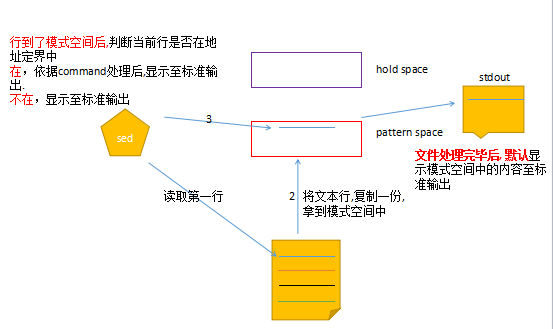
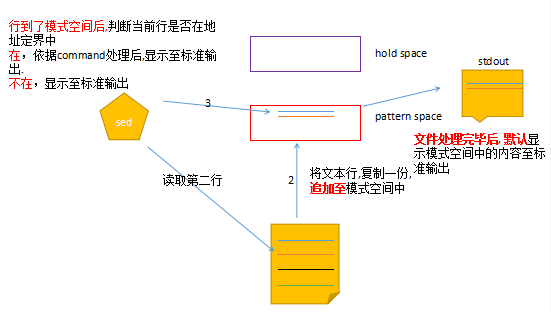
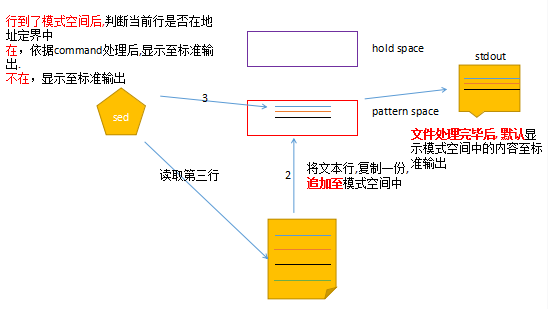
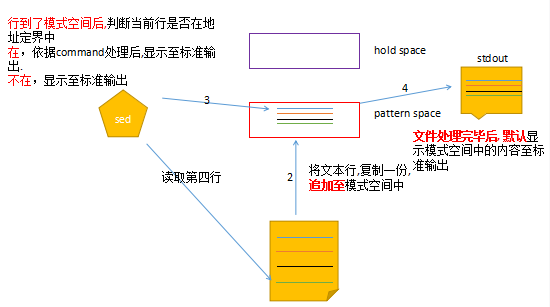
sed基本使用
格式一:
sed [OPTION ...] [SCRIPT] [FILE...] 多個文件處理: 處理完一個,繼續處理第二個。 sed script file1 --> sed script file2 使用方法基本同vim命令 1)vim % --> sed 不用指明 2)vim @@ ## // --> sed || ,, @@ //

格式二:
sed ‘地址定界command‘ FILE ...
1)地址定界



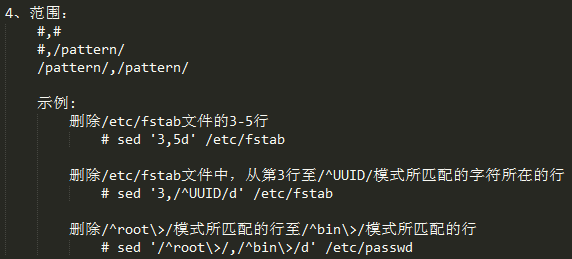
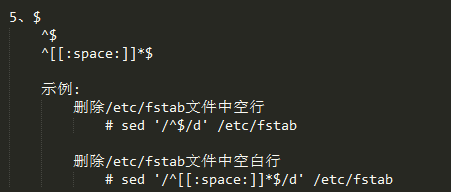
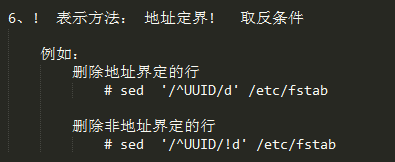
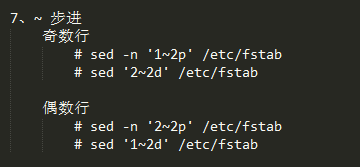
2)command
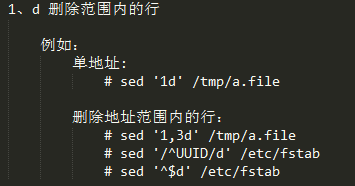
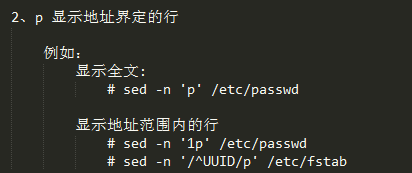
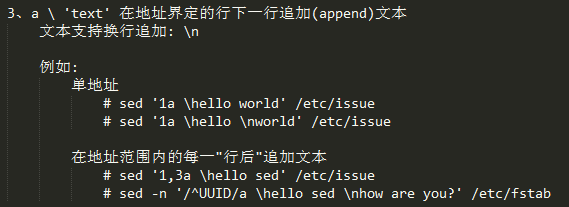
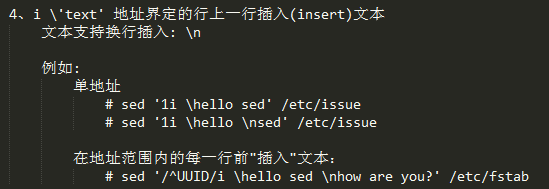
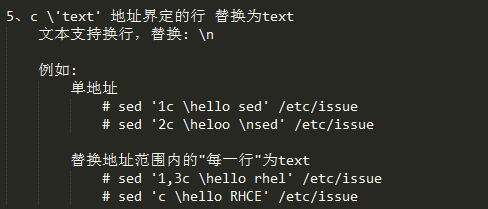


例如: 將文件中的內容插入至指定文件中 # sed ‘/^UUID/r /etc/issue‘ /etc/fstab # sed ‘1,3r /etc/centos-release‘ /etc/issue


例如: 取一個文件的基名、目錄名 基名: echo "/etc/sysconfig/useradd/" | sed ‘s,/$,,‘ | sed -r ‘s|(.*/)([^/]+)|\2|‘ 目錄名: echo "/etc/sysconfig/useradd/" | sed ‘s,/$,,‘ | sed -r ‘s|(.*/)([^/]+)|\2|‘


例如: # echo "how are you" | sed -r ‘s/(how)(.*)(you)/\3\2\1/‘ # echo "how are you" | sed -r ‘[email protected](how)(.*)(you)@\3\2\[email protected]‘ # echo "how are you" | sed -r ‘s#(how)(.*)(you)#\3\2\1#‘ # echo "how are you" | sed -r ‘s,(how)(.*)(you),\3\2\1,‘ # echo "how are you" | sed -r ‘s|(how)(.*)(you)|\3\2\1|‘

例如: [[email protected] bin]# head -n 1 < /etc/passwd | sed ‘s,root,ROOT,‘ ROOT:x:0:0:root:/root:/bin/bash [[email protected] bin]# head -n 1 < /etc/passwd | sed ‘s,root,ROOT,g‘ ROOT:x:0:0:ROOT:/ROOT:/bin/bash

例如: [[email protected] bin]# head -n 1 < /etc/passwd | sed ‘s,rOOt,ROOT,i‘ ROOT:x:0:0:root:/root:/bin/bash [[email protected] bin]# head -n 1 < /etc/passwd | sed ‘s,rOOt,ROOT,gi‘ ROOT:x:0:0:ROOT:/ROOT:/bin/bash

例如: [[email protected] bin]# cat < /etc/passwd | sed -n ‘s,rOOt,ROOT,ip‘ ROOT:x:0:0:root:/root:/bin/bash operator:x:11:0:operator:/ROOT:/sbin/nologin

# sed ‘s,,,w /PATH/TO/SOMEFILE‘ FILE # sed ‘s,,,‘ FILE > /PTH/TO/SOMEFILE
練習1:刪除/boot/grub/grub.conf文本中所有以空白開頭的行行首的空白字符
練習2:刪除/etc/fstab文件中所有以#開頭,後面至少跟一個空白字符的行的行首的#和空白字符
練習3:echo 一個絕對路徑給sed命令:取出其基名,取出目錄名
練習1:刪除/boot/grub/grub.conf文本中所有以空白開頭的行行首的空白字符
CentOS 6:
# cp /boot/grub/grub.conf /tmp/grub.conf
# sed -i ‘s,^[[:space:]]\+,,‘ /tmp/grub.conf
CentOS 7:
# cp /etc/grub2.cfg /tmp/grub2.cfg
# sed -i ‘s,^[[:space:]]\+,,‘ /tmp/grub2.cfg練習2:刪除/etc/fstab文件中所有以#開頭,後面至少跟一個空白字符的行的行首的#和空白字符
# cp /etc/fstab /tmp/a.file # sed -i -r ‘s|^#[[:space:]]+||‘ /tmp/a.file 擴展:刪除以#開頭,後面沒有跟空白字符的行的行首的# # cp /etc/fstab /tmp/fstab # echo "#hello sed" >> /tmp/fstab # sed -i -r ‘[email protected]^#([^[:space:]].*)@\[email protected]‘ /etc/fstab
練習3:echo 一個絕對路徑給sed命令:取出其基名,取出目錄名
測試取出文件名中存在 useradd的絕對路徑 # locate -b useradd ... /usr/share/man/zh_CN/man8/useradd.8.gz /usr/share/man/zh_TW/man8/useradd.8.gz ... 取出/usr/share/man/zh_TW/man8/useradd.8.gz的基名 # echo "/usr/share/man/zh_TW/man8/useradd.8.gz/" | sed ‘s,/$,,‘ | sed -r ‘s#(.*/)([^/]+$)#\2#‘ 取出/usr/share/man/zh_TW/man8/useradd.8.gz的目錄名 # echo "/usr/share/man/zh_TW/man8/useradd.8.gz" | sed ‘s,/$,,‘ | sed -r ‘s#(.*/)([^/]+$)#\1#‘
格式三:
sed ‘地址定界command;地址定界command;地址定界command;...‘
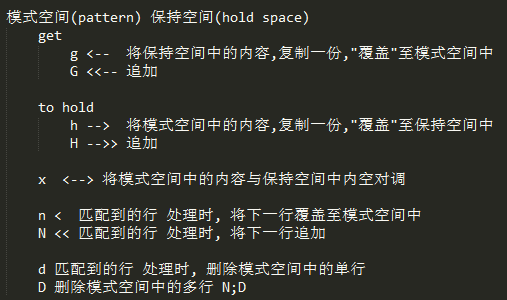
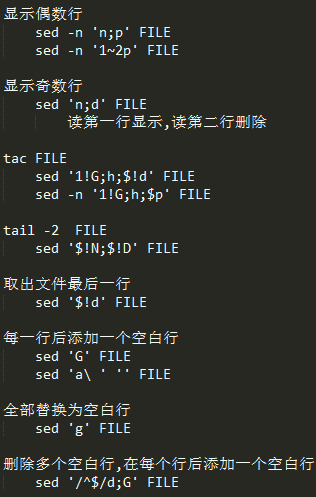
本文出自 “Reading” 博客,請務必保留此出處http://sonlich.blog.51cto.com/12825953/1964161
謝煙客---------Linux之 sed工具使用
